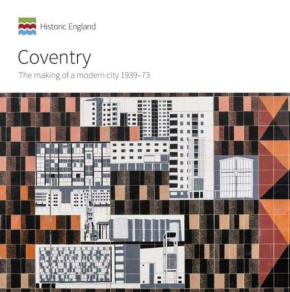Coventry: the making of a modern city, 1939-73
Coventry: the making of a modern city, 1939–73, Jeremy and Caroline Gould, Historic England, 2016, 156 pages, 128 colour and black-and-white illustrations, softback.
The Coventry blitz on 14 November 1940 largely destroyed the medieval city on a single night. For the city architect, Donald Gibson, who was already engaged in planning for change, it offered an opportunity to invent the modern city. With the backing of a progressive and socially-minded council, the redevelopment by Gibson and his successors resulted in an intensely urban and civilised centre, which in turn influenced the rebuilding of other shattered city centres and the post-war new town movement. In spite of later changes, both the original vision and the architecture remain substantially intact, even if their value is not always understood. The Goulds’ sensitive analysis of the city within this exemplary book aims to inform the public and decision makers of Coventry’s significance, so that the best of its remarkable post-war heritage can survive.
This article originally appeared in IHBC's Context 162 (Page 58), published by The Institute of Historic Building Conservation in November 2019.
--Institute of Historic Building Conservation
Related articles on Designing Buildings Wiki
- British post-war mass housing.`
- Demolishing Modernism: Britain's lost post-war gems.
- French new towns.
- Garden communities and the historic environment
- Harlow new town.
- IHBC articles.
- New town heritage.
- New towns.
- Post-war new towns in Germany.
- Post-war rebuilding.
- Socialist realism in a post-war Czechoslovak new town.
- The Institute of Historic Building Conservation.
IHBC NewsBlog
Old Sarum fire in listed (& disputed) WW1 Hangar - Wiltshire Council has sought legal advice after fire engulfed a listed First World War hangar that was embroiled in a lengthy planning dispute.
UK Antarctic Heritage Trust launches ‘Virtual Visit’ website area
The Trust calls on people to 'Immerse yourself in our heritage – Making Antarctica Accessible'
Southend Council pledge to force Kursaal owners to maintain building
The Council has pledged to use ‘every tool in the toolbox’ if urgent repairs are not carried out.
HE’s Research Magazine publishes a major study of the heritage of England’s suburbs
The article traces the long evolution of an internal programme to research 200 years of suburban growth
IHBC Context 183 Wellbeing and Heritage published
The issue explores issues at the intersection of heritage and wellbeing.
SAVE celebrates 50 years of campaigning 1975-2025
SAVE Britain’s Heritage has announced events across the country to celebrate bringing new life to remarkable buildings.
IHBC Annual School 2025 - Shrewsbury 12-14 June
Themed Heritage in Context – Value: Plan: Change, join in-person or online.
200th Anniversary Celebration of the Modern Railway Planned
The Stockton & Darlington Railway opened on September 27, 1825.
Competence Framework Launched for Sustainability in the Built Environment
The Construction Industry Council (CIC) and the Edge have jointly published the framework.
Historic England Launches Wellbeing Strategy for Heritage
Whether through visiting, volunteering, learning or creative practice, engaging with heritage can strengthen confidence, resilience, hope and social connections.















